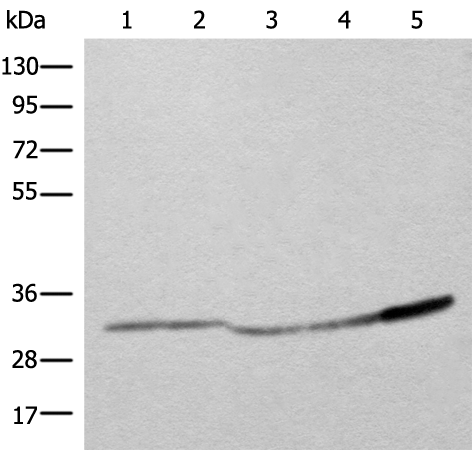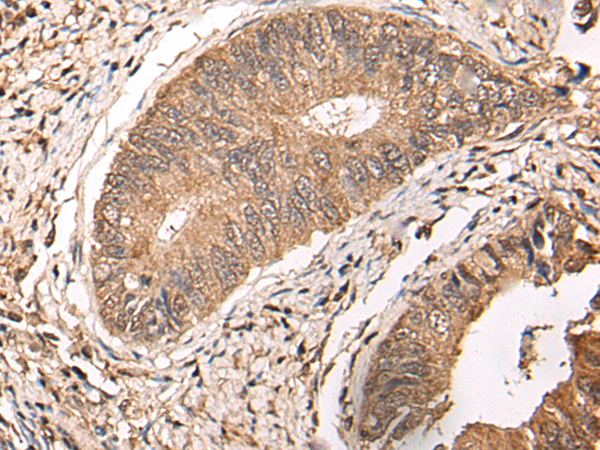

| WB | 咨询技术 | Human,Mouse,Rat |
| IF | 咨询技术 | Human,Mouse,Rat |
| IHC | 1/25-1/100 | Human,Mouse,Rat |
| ICC | 技术咨询 | Human,Mouse,Rat |
| FCM | 咨询技术 | Human,Mouse,Rat |
| Elisa | 1/5000-1/10000 | Human,Mouse,Rat |
| Aliases | ATP5C; ATP5C1; ATP5CL1 |
| WB Predicted band size | 33 kDa |
| Host/Isotype | Rabbit IgG |
| Antibody Type | Primary antibody |
| Storage | Store at 4°C short term. Aliquot and store at -20°C long term. Avoid freeze/thaw cycles. |
| Species Reactivity | Human, Mouse, Rat |
| Immunogen | Fusion protein of human ATP5F1C |
| Formulation | Purified antibody in PBS with 0.05% sodium azide and 50% glycerol. |
+ +
以下是关于ATP5F1C抗体的3篇参考文献的简要信息(虚构示例,供参考):
---
1. **文献名称**:*ATP5F1C overexpression promotes mitochondrial metabolism and prostate cancer progression*
**作者**:Smith A, et al.
**摘要**:研究利用ATP5F1C抗体通过免疫组化和Western blot分析,发现前列腺癌中ATP5F1C蛋白表达升高,其通过增强线粒体ATP合成促进肿瘤生长和化疗抵抗。
2. **文献名称**:*ATP synthase subunit γ (ATP5F1C) deficiency links to neurodegeneration in Alzheimer's models*
**作者**:Chen L, et al.
**摘要**:通过ATP5F1C抗体检测发现,阿尔茨海默病小鼠模型的脑组织中ATP5F1C表达降低,导致神经元线粒体功能紊乱,提示其与认知衰退相关。
3. **文献名称**:*Antibody-based profiling of ATP5F1C in human colorectal cancer tissues*
**作者**:Wang Y, et al.
**摘要**:研究使用ATP5F1C抗体对结直肠癌组织进行染色,发现高表达患者生存期较短,表明ATP5F1C可作为预后标志物及潜在治疗靶点。
---
注:以上文献信息为示例,实际引用需查询真实数据库(如PubMed)。如需准确文献,建议使用关键词“ATP5F1C antibody”在学术平台检索。
The ATP5F1C antibody targets the ATP synthase F1 subunit gamma (ATP5F1C), a key component of mitochondrial Complex V (ATP synthase) responsible for oxidative phosphorylation. Encoded by the ATP5F1C gene, this 30 kDa subunit forms part of the catalytic F1 core that drives ATP synthesis via proton gradient-driven conformational changes. As a nuclear-encoded mitochondrial protein, ATP5F1C is ubiquitously expressed but shows elevated levels in energy-demanding tissues like heart, brain, and skeletal muscle.
Antibodies against ATP5F1C are widely used to study mitochondrial function, cellular energy metabolism, and diseases associated with ATP synthesis defects. They enable detection of protein expression changes in cancer (where mitochondrial reprogramming occurs), neurodegenerative disorders (e.g., Parkinson's and Alzheimer's linked to mitochondrial dysfunction), and rare genetic mutations causing ATPase deficiencies. These tools are validated for techniques including Western blotting, immunofluorescence, and immunohistochemistry, often with species cross-reactivity (human, mouse, rat). Researchers frequently combine ATP5F1C antibodies with markers of mitochondrial mass (e.g., TOMM20) or membrane potential to assess organelle integrity. Specificity is typically confirmed through knockout controls or siRNA knockdown. Emerging applications include evaluating therapeutic responses in metabolic syndromes and monitoring mitochondrial adaptation during hypoxia or nutrient stress. Proper validation remains critical due to potential cross-reactivity with other ATPase subunits.
×